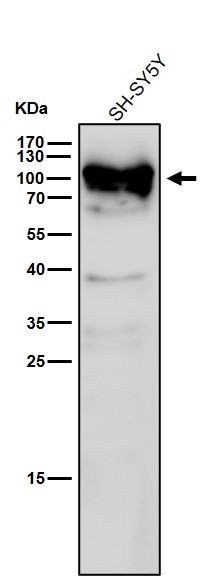
| WB | 1/1000-1/5000 | Human,Mouse,Rat |
| IF | 咨询技术 | Human,Mouse,Rat |
| IHC | 咨询技术 | Human,Mouse,Rat |
| ICC | 1/50-1/200 | Human,Mouse,Rat |
| FCM | 1/20-1/100 | Human,Mouse,Rat |
| Elisa | 咨询技术 | Human,Mouse,Rat |
| Aliases | U4/U6.U5 tri-snRNP-associated protein 1, SART1, SNU66 homolog (hSnu66), Squamous cell carcinoma antigen recognized by T-cells 1 (SART-1; hSART-1), U4/U6.U5 tri-snRNP-associated 110 kDa protein;SART1 |
| WB Predicted band size | Calculated MW: 90 kDa ; Observed MW: 110 kDa |
| Host/Isotype | Rabbit IgG |
| Antibody Type | Primary antibody |
| Storage | Store at 4°C short term. Aliquot and store at -20°C long term. Avoid freeze/thaw cycles. |
| Species Reactivity | Human,Mouse,Rat |
| Immunogen | A synthesized peptide derived from human SART1 |
| Formulation | Purified antibody in PBS with 0.05% sodium azide,0.05% BSA and 50% glycerol. |
+ +
以下是关于SART1抗体的3篇参考文献及其摘要内容概括:
1. **《Identification of a gene coding for a new squamous cell carcinoma antigen recognized by the cytotoxic T lymphocytes》**
- **作者**:Shichijo, S., et al. (1998)
- **摘要**:该研究首次克隆了SART1基因,发现其编码的抗原肽在鳞状细胞癌细胞中高表达,并被细胞毒性T淋巴细胞(CTL)识别。研究通过抗体验证了其在肿瘤免疫中的潜在作用,为癌症疫苗开发提供了依据。
2. **《A testicular antigen aberrantly expressed in human cancers detected by autologous antibody screening》**
- **作者**:Robbins, P.F., et al. (1997)
- **摘要**:通过自体抗体筛选技术,发现SART1在多种肿瘤组织中异常表达,而在正常组织中仅见于睾丸。研究利用抗体检测证实了SART1作为肿瘤相关抗原的潜力,并探讨了其在免疫治疗中的应用。
3. **《Serum anti-SART1 antibody as a novel biomarker for early-stage esophageal squamous cell carcinoma》**
- **作者**:Hijikata, A., et al. (2005)
- **摘要**:研究通过ELISA检测发现,食管鳞癌患者血清中抗SART1抗体的阳性率显著高于健康人群,提示其可作为早期诊断的生物标志物,并可能参与肿瘤免疫监视机制。
4. **《Humoral immune responses to SART1 tumor antigen in lung cancer patients》**
- **作者**:Yamada, T., et al. (2001)
- **摘要**:分析了肺癌患者血清中抗SART1抗体的水平,发现抗体阳性与肿瘤分期及预后相关,表明SART1抗体可能具有临床评估价值,并支持其在肿瘤免疫应答中的重要性。
SART1 antibodies target the SART1 (squamous cell carcinoma antigen recognized by T cells 1) protein, a dual-function molecule involved in mRNA splicing and tumor antigen presentation. The SART1 gene encodes two major isoforms: SART1-800 (nucleus-specific) and SART1-1025 (cytoplasm-specific). SART1-800 participates in pre-mRNA splicing as a component of the U4/U6.U5 tri-snRNP complex, while SART1-1025 is processed into peptides presented by HLA class I molecules on tumor cells, eliciting cytotoxic T lymphocyte (CTL) responses against cancers.
Overexpressed in various malignancies (e.g., squamous cell carcinomas of the head, neck, and esophagus), SART1 serves as a tumor-associated antigen, making it a target for cancer immunotherapy. Antibodies against SART1 are primarily used in research to detect protein expression/localization, study its role in mRNA processing, and evaluate its immunogenicity in tumor models. Clinically, SART1-derived peptides have been tested in vaccine trials to activate antitumor immunity. However, its dual role complicates therapeutic applications, as nuclear SART1-800 is essential for cell viability, whereas cytoplasmic SART1-1025 drives immune recognition. This functional dichotomy underscores the need for isoform-specific antibody tools to dissect SART1's contributions to both oncogenesis and immune surveillance.
×